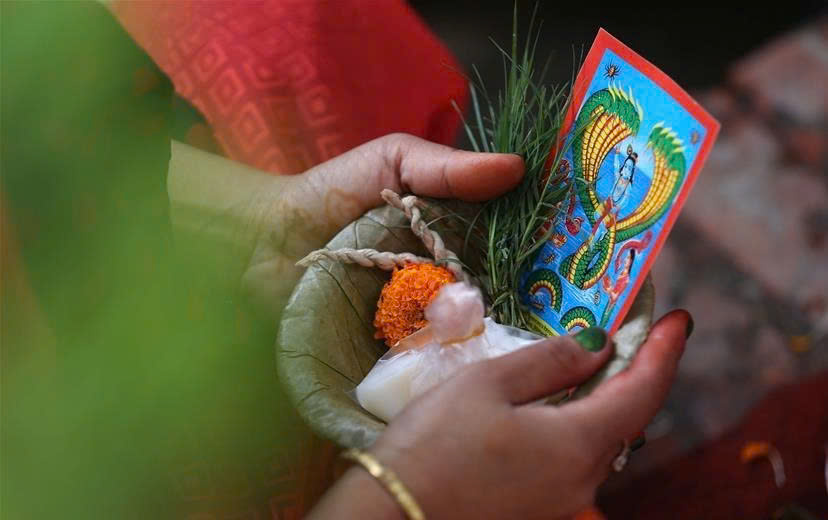It is not by chance that many people suffer from Ophidiophobia - fear of snakes. This is not a disease but a psychological syndrome for people who are born with a fear of all kinds of snakes even though they have never seen them, or fear things that look like snakes such as tree branches, strips of cloth...
No one has been able to explain this fear mechanism, which has been written into the genetic code of humans since primitive times. Fear leads to a phenomenon: worship. It can be said that snakes have been worshiped by humans since very early times, right from the beginning of societies.
The serpent was considered the supreme deity of the Aztec civilization in North America, centered in Mexico. Interpreted Aztec texts indicate that the Aztecs worshiped a feathered serpent from 400 to 600 BC. This belief spread throughout the North and Central American continents between 600 and 900 BC.
Later, when the Mayan civilization took over, this god was given a name, Quetzalcoatl - meaning Feathered Serpent. Quetzalcoatl became the central deity of a vast continent, symbolizing wisdom, intelligence, learning and was related to Venus - a very important star in the ancient astrological and astronomical system.
In Asia, snakes are the most sacred creatures to Hindus and Hinduism. In the largest culture of the East, which is the cradle of many religions and beliefs, snakes represent the supreme gods and are called Naga (great python).
The Naga snake god is associated with the two most sacred gods of Hinduism, Vishnu and Shiva, with the meaning of curling around the root of the axis of the world, symbolizing birth, development and destruction, and at the same time supporting and ensuring the stability of the world. The most famous Naga temple is the Naga temple in Kerala.
Nagas and snakes also appear a lot in Indian architecture and sculpture as symbols of immortality, protectors and guardians. The Naga symbol later became considered the king of snakes, the protector of women. Therefore, any woman who wanted to have a child often had to adopt a cobra.

When Buddhism spread from India to the south via the Southern sect, a series of countries along this route also worshiped the snake god Naga, as a guardian deity, protecting Buddhism. Therefore, in Myanmar, Thailand, Laos, and Cambodia, the image of Naga also became popular.
Thai people also consider Naga as the snake god, a symbol of femininity. Therefore, Thai art uses the beauty of snakes to describe the beauty of women and is very taboo about killing snakes, even poisonous snakes. Thai people also built many temples to worship snakes.
The greatest snake temple, however, is in Cambodia, with Naga figures appearing throughout the world wonder Angkor Wat. The Khmer monument pays the highest tribute to the snake, with Naga figures intricately carved into its walls and gateways.
The Khmer consider Naga as the guardian deity of the temple's sacredness and inviolability. The Naga sculptures at Angkor Wat are not only beautiful but also contain many stories and legends imbued with Khmer culture and the philosophy of life of this nation.
The Khmer believe that the three-headed Naga symbolizes the three talents. The five-headed Naga symbolizes the five elements. The seven-headed Naga symbolizes enlightenment in religious practice, and the highest is the nine-headed Naga, synonymous with Nirvana.
Putting aside their fear, humans still worship snakes out of boundless respect. Snakes are symbols of immortality as humans witness snakes being reborn after each shedding of their skin. The wildest dream of humans has always been immortality. That immortal snake should be respected and admired by humans.
In Vietnamese folklore, snake worship is a primitive belief with two main meanings: totem and water god. Both are related to the custom of making a living on the river and the wet rice civilization. And the snake is the god that governs the river, worshiped along the Red River.
In addition, snakes are worshiped by Vietnamese people most in temples and shrines of the Mother Goddess religion. This traditional belief considers snakes as symbols of fertility, growth, shelter and protection. Almost every temple has a symbol of a pair of snakes coiled on both sides of the altar, while snake images are carved and painted on the rafters of the temples.
However, although feared and respected, snakes cannot escape gossip. All the most evil and vicious things are associated with the symbol of snakes. Even in the Christian Bible, the snake persuaded Adam and Eve to eat the forbidden fruit, which led to their becoming husband and wife and being banished from the Garden of Eden by God.
The serpent was considered the culprit who prevented humans from living in paradise, even inciting humans to indulge in lust to the point of losing the purity of their souls and falling into great sin. The serpent turned Eve into an evil person, and from then on, women were guilty of the “original sin” and had to suffer pain during childbirth.
In Vietnamese culture, snakes are also a symbol of bad things. The most typical is the statue of a snake biting itself buried near the temple of Grand Tutor Le Van Thinh of the Ly Dynasty (Gia Binh, Bac Ninh). This outstanding figure of the Ly Nhan Tong Dynasty was wrongly accused of "turning into a tiger in West Lake to kill the king" and was then executed.
Or like in the Le Chi Vien case, before Nguyen Trai was executed for plotting to assassinate King Le Thai Tong at his manor, he was also warned by a snake that a drop of blood fell on the page of the book that Nguyen Trai was reading, and that drop of blood fell on the word Dai (life) and soaked through 3 pages. Thus, 3 generations of Nguyen Trai's family died unjustly because of the snake's revenge.
Even when he wanted to justify his laziness in studying, the scholar Le Quy Don, when he was young, used snakes as an object to blame with a famous poem in which every verse has the name of a snake:
Not all trees are like homes.
Lazy snake does not forgive
The tiger lamp is shy, the fire is heartbreaking for mother.
Now screaming Mai roars until her father's throat is sore
The mouth is only used to talking nonsense.
The back of the patient has a few traces.
From now on, Buffalo and Lo will study hard.
The Tiger carries the reputation of the family.
So, we can see, the story of the snake mascot is perhaps the most interesting among the 12 zodiac animals and among the animals used as symbols. No symbol is as admired, worshiped and feared as the snake.
However, snakes are still indifferent to the love and hate of humans in different cultures! And this year 2025 is the year of At Ty and people born in this year are said to be very intelligent, especially sharp in philosophy, with good thinking ability. Aren't those the qualities of snakes?
(Posted on the special edition of Labor Weekend Spring At Ty)











